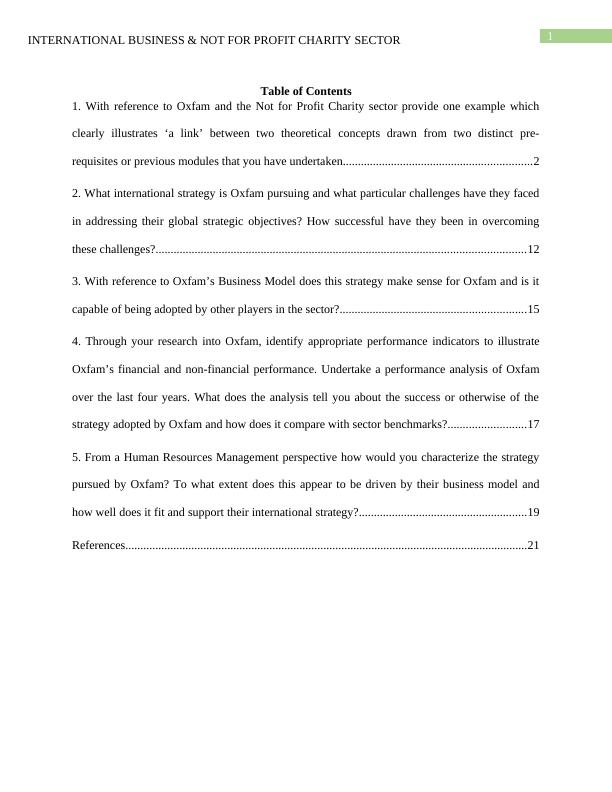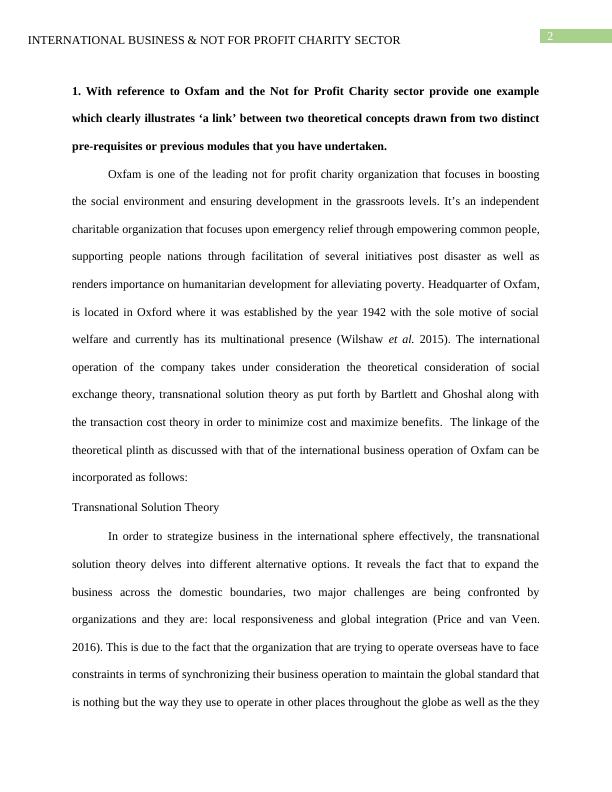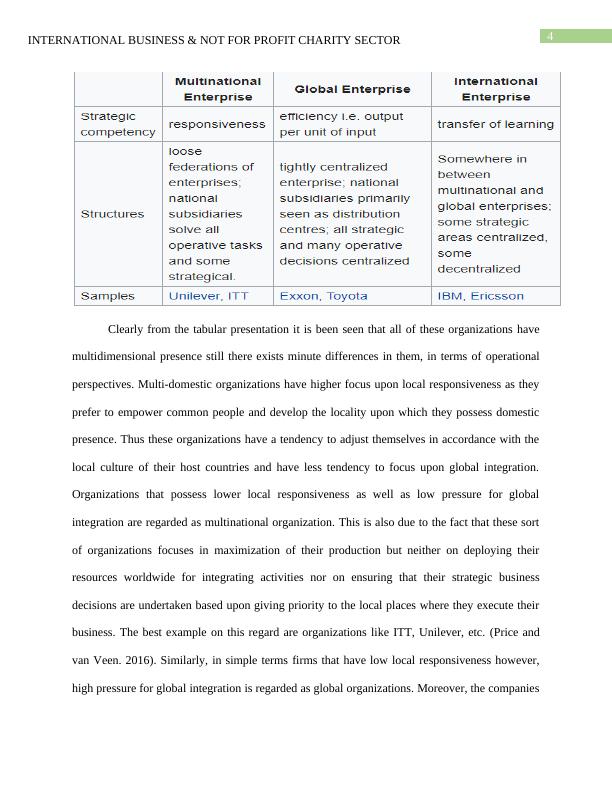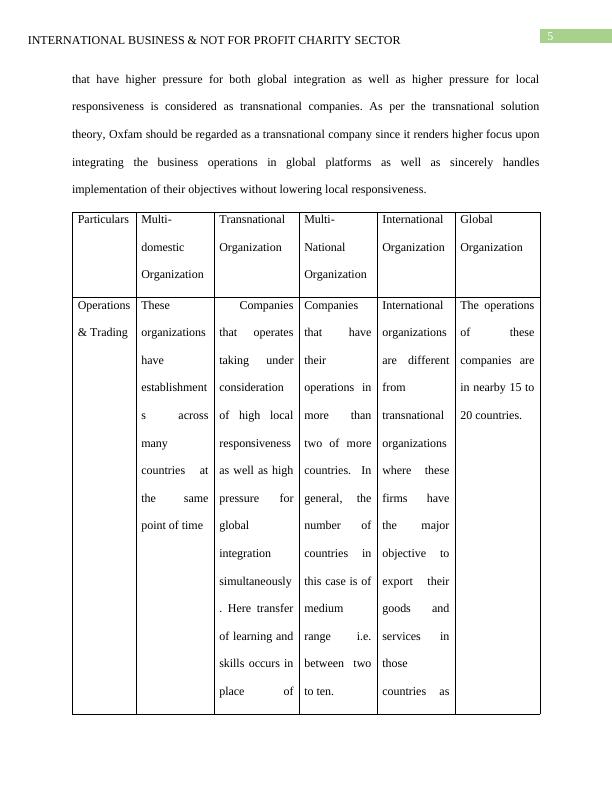International Business & Not for Profit Charity Sector
Added on 2023-04-05
24 Pages4802 Words311 Views
0
Running head: INTERNATIONAL BUSINESS & NOT FOR PROFIT CHARITY SECTOR
INTERNATIONAL BUSINESS & NOT FOR PROFIT CHARITY SECTOR
Name of the Student
Name of the University
Author’s Note
Running head: INTERNATIONAL BUSINESS & NOT FOR PROFIT CHARITY SECTOR
INTERNATIONAL BUSINESS & NOT FOR PROFIT CHARITY SECTOR
Name of the Student
Name of the University
Author’s Note

1INTERNATIONAL BUSINESS & NOT FOR PROFIT CHARITY SECTOR
Table of Contents
1. With reference to Oxfam and the Not for Profit Charity sector provide one example which
clearly illustrates ‘a link’ between two theoretical concepts drawn from two distinct pre-
requisites or previous modules that you have undertaken...............................................................2
2. What international strategy is Oxfam pursuing and what particular challenges have they faced
in addressing their global strategic objectives? How successful have they been in overcoming
these challenges?...........................................................................................................................12
3. With reference to Oxfam’s Business Model does this strategy make sense for Oxfam and is it
capable of being adopted by other players in the sector?..............................................................15
4. Through your research into Oxfam, identify appropriate performance indicators to illustrate
Oxfam’s financial and non-financial performance. Undertake a performance analysis of Oxfam
over the last four years. What does the analysis tell you about the success or otherwise of the
strategy adopted by Oxfam and how does it compare with sector benchmarks?..........................17
5. From a Human Resources Management perspective how would you characterize the strategy
pursued by Oxfam? To what extent does this appear to be driven by their business model and
how well does it fit and support their international strategy?........................................................19
References......................................................................................................................................21
Table of Contents
1. With reference to Oxfam and the Not for Profit Charity sector provide one example which
clearly illustrates ‘a link’ between two theoretical concepts drawn from two distinct pre-
requisites or previous modules that you have undertaken...............................................................2
2. What international strategy is Oxfam pursuing and what particular challenges have they faced
in addressing their global strategic objectives? How successful have they been in overcoming
these challenges?...........................................................................................................................12
3. With reference to Oxfam’s Business Model does this strategy make sense for Oxfam and is it
capable of being adopted by other players in the sector?..............................................................15
4. Through your research into Oxfam, identify appropriate performance indicators to illustrate
Oxfam’s financial and non-financial performance. Undertake a performance analysis of Oxfam
over the last four years. What does the analysis tell you about the success or otherwise of the
strategy adopted by Oxfam and how does it compare with sector benchmarks?..........................17
5. From a Human Resources Management perspective how would you characterize the strategy
pursued by Oxfam? To what extent does this appear to be driven by their business model and
how well does it fit and support their international strategy?........................................................19
References......................................................................................................................................21

2INTERNATIONAL BUSINESS & NOT FOR PROFIT CHARITY SECTOR
1. With reference to Oxfam and the Not for Profit Charity sector provide one example
which clearly illustrates ‘a link’ between two theoretical concepts drawn from two distinct
pre-requisites or previous modules that you have undertaken.
Oxfam is one of the leading not for profit charity organization that focuses in boosting
the social environment and ensuring development in the grassroots levels. It’s an independent
charitable organization that focuses upon emergency relief through empowering common people,
supporting people nations through facilitation of several initiatives post disaster as well as
renders importance on humanitarian development for alleviating poverty. Headquarter of Oxfam,
is located in Oxford where it was established by the year 1942 with the sole motive of social
welfare and currently has its multinational presence (Wilshaw et al. 2015). The international
operation of the company takes under consideration the theoretical consideration of social
exchange theory, transnational solution theory as put forth by Bartlett and Ghoshal along with
the transaction cost theory in order to minimize cost and maximize benefits. The linkage of the
theoretical plinth as discussed with that of the international business operation of Oxfam can be
incorporated as follows:
Transnational Solution Theory
In order to strategize business in the international sphere effectively, the transnational
solution theory delves into different alternative options. It reveals the fact that to expand the
business across the domestic boundaries, two major challenges are being confronted by
organizations and they are: local responsiveness and global integration (Price and van Veen.
2016). This is due to the fact that the organization that are trying to operate overseas have to face
constraints in terms of synchronizing their business operation to maintain the global standard that
is nothing but the way they use to operate in other places throughout the globe as well as the they
1. With reference to Oxfam and the Not for Profit Charity sector provide one example
which clearly illustrates ‘a link’ between two theoretical concepts drawn from two distinct
pre-requisites or previous modules that you have undertaken.
Oxfam is one of the leading not for profit charity organization that focuses in boosting
the social environment and ensuring development in the grassroots levels. It’s an independent
charitable organization that focuses upon emergency relief through empowering common people,
supporting people nations through facilitation of several initiatives post disaster as well as
renders importance on humanitarian development for alleviating poverty. Headquarter of Oxfam,
is located in Oxford where it was established by the year 1942 with the sole motive of social
welfare and currently has its multinational presence (Wilshaw et al. 2015). The international
operation of the company takes under consideration the theoretical consideration of social
exchange theory, transnational solution theory as put forth by Bartlett and Ghoshal along with
the transaction cost theory in order to minimize cost and maximize benefits. The linkage of the
theoretical plinth as discussed with that of the international business operation of Oxfam can be
incorporated as follows:
Transnational Solution Theory
In order to strategize business in the international sphere effectively, the transnational
solution theory delves into different alternative options. It reveals the fact that to expand the
business across the domestic boundaries, two major challenges are being confronted by
organizations and they are: local responsiveness and global integration (Price and van Veen.
2016). This is due to the fact that the organization that are trying to operate overseas have to face
constraints in terms of synchronizing their business operation to maintain the global standard that
is nothing but the way they use to operate in other places throughout the globe as well as the they

3INTERNATIONAL BUSINESS & NOT FOR PROFIT CHARITY SECTOR
have to come up with the local demand or enhance the existing demand for the quality goods and
services that they deploy into the target market abroad. In order to emphasize upon this issue the
Bartlett & Ghoshal matrix can be incorporated as follows:
Figure 1: Bartlett & Ghoshal Matrix
To understand the matrix appropriately it is important to understand the difference
between global, international as well as transnational organizations (Wilshaw et al. 2015). This is
being clarified below:
have to come up with the local demand or enhance the existing demand for the quality goods and
services that they deploy into the target market abroad. In order to emphasize upon this issue the
Bartlett & Ghoshal matrix can be incorporated as follows:
Figure 1: Bartlett & Ghoshal Matrix
To understand the matrix appropriately it is important to understand the difference
between global, international as well as transnational organizations (Wilshaw et al. 2015). This is
being clarified below:

4INTERNATIONAL BUSINESS & NOT FOR PROFIT CHARITY SECTOR
Clearly from the tabular presentation it is been seen that all of these organizations have
multidimensional presence still there exists minute differences in them, in terms of operational
perspectives. Multi-domestic organizations have higher focus upon local responsiveness as they
prefer to empower common people and develop the locality upon which they possess domestic
presence. Thus these organizations have a tendency to adjust themselves in accordance with the
local culture of their host countries and have less tendency to focus upon global integration.
Organizations that possess lower local responsiveness as well as low pressure for global
integration are regarded as multinational organization. This is also due to the fact that these sort
of organizations focuses in maximization of their production but neither on deploying their
resources worldwide for integrating activities nor on ensuring that their strategic business
decisions are undertaken based upon giving priority to the local places where they execute their
business. The best example on this regard are organizations like ITT, Unilever, etc. (Price and
van Veen. 2016). Similarly, in simple terms firms that have low local responsiveness however,
high pressure for global integration is regarded as global organizations. Moreover, the companies
Clearly from the tabular presentation it is been seen that all of these organizations have
multidimensional presence still there exists minute differences in them, in terms of operational
perspectives. Multi-domestic organizations have higher focus upon local responsiveness as they
prefer to empower common people and develop the locality upon which they possess domestic
presence. Thus these organizations have a tendency to adjust themselves in accordance with the
local culture of their host countries and have less tendency to focus upon global integration.
Organizations that possess lower local responsiveness as well as low pressure for global
integration are regarded as multinational organization. This is also due to the fact that these sort
of organizations focuses in maximization of their production but neither on deploying their
resources worldwide for integrating activities nor on ensuring that their strategic business
decisions are undertaken based upon giving priority to the local places where they execute their
business. The best example on this regard are organizations like ITT, Unilever, etc. (Price and
van Veen. 2016). Similarly, in simple terms firms that have low local responsiveness however,
high pressure for global integration is regarded as global organizations. Moreover, the companies

5INTERNATIONAL BUSINESS & NOT FOR PROFIT CHARITY SECTOR
that have higher pressure for both global integration as well as higher pressure for local
responsiveness is considered as transnational companies. As per the transnational solution
theory, Oxfam should be regarded as a transnational company since it renders higher focus upon
integrating the business operations in global platforms as well as sincerely handles
implementation of their objectives without lowering local responsiveness.
Particulars Multi-
domestic
Organization
Transnational
Organization
Multi-
National
Organization
International
Organization
Global
Organization
Operations
& Trading
These
organizations
have
establishment
s across
many
countries at
the same
point of time
Companies
that operates
taking under
consideration
of high local
responsiveness
as well as high
pressure for
global
integration
simultaneously
. Here transfer
of learning and
skills occurs in
place of
Companies
that have
their
operations in
more than
two of more
countries. In
general, the
number of
countries in
this case is of
medium
range i.e.
between two
to ten.
International
organizations
are different
from
transnational
organizations
where these
firms have
the major
objective to
export their
goods and
services in
those
countries as
The operations
of these
companies are
in nearby 15 to
20 countries.
that have higher pressure for both global integration as well as higher pressure for local
responsiveness is considered as transnational companies. As per the transnational solution
theory, Oxfam should be regarded as a transnational company since it renders higher focus upon
integrating the business operations in global platforms as well as sincerely handles
implementation of their objectives without lowering local responsiveness.
Particulars Multi-
domestic
Organization
Transnational
Organization
Multi-
National
Organization
International
Organization
Global
Organization
Operations
& Trading
These
organizations
have
establishment
s across
many
countries at
the same
point of time
Companies
that operates
taking under
consideration
of high local
responsiveness
as well as high
pressure for
global
integration
simultaneously
. Here transfer
of learning and
skills occurs in
place of
Companies
that have
their
operations in
more than
two of more
countries. In
general, the
number of
countries in
this case is of
medium
range i.e.
between two
to ten.
International
organizations
are different
from
transnational
organizations
where these
firms have
the major
objective to
export their
goods and
services in
those
countries as
The operations
of these
companies are
in nearby 15 to
20 countries.

End of preview
Want to access all the pages? Upload your documents or become a member.
Related Documents
EBWO3001 Effectiveness in the Business World : Assignmentlg...
|10
|2809
|171
Explaining JB Hi-Fi's Reporting Decisions and Profit Downgrade using Institutional and Managerial Branch of Stakeholder Theorylg...
|16
|5991
|301
Accounting and Finance for Managerslg...
|12
|2760
|30
Accounting and Finance for Managerslg...
|17
|3880
|57
